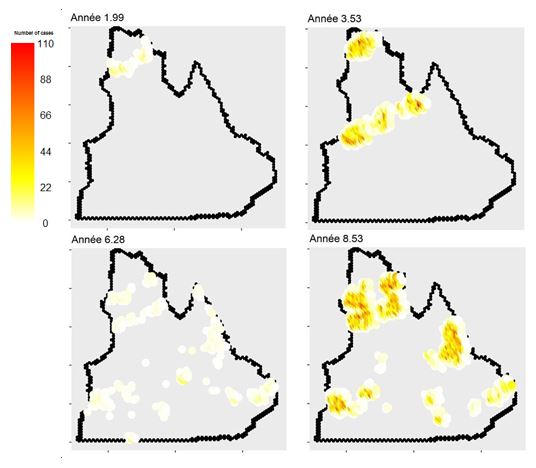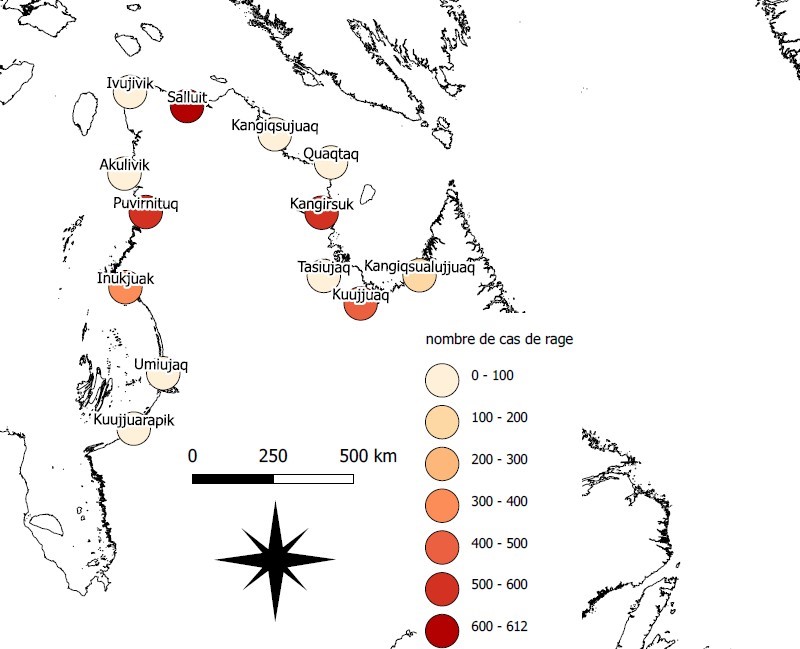Modelling the future of Arctic fox rabies dynamics associated risk management
The results of this project will be very useful in assisting with the planning of public health measures to prevent human exposure to rabies from foxes in the rapidly changing climate of Nunavik and Labrador.
Project details
Principal(s) investigator(s)

Context
The Arctic fox (Vulpes lagopus) lives in northern regions. In winter, it can travel several hundred kilometres across sea ice to feed. Another species of fox, the red fox (Vulpes vulpes), is also found in the Arctic. The extent of the Arctic ecosystem, as well as the presence of the red fox, may limit the southern distribution of the Arctic fox. Rabies, a disease that is fatal to humans, persists in populations of the Arctic fox, its main reservoir species. However, red foxes can also be infected and transmit the disease further south, as has already been observed.
In the Arctic regions, sea ice and snow cover are being affected by climate change. In addition to these physical effects, the entire terrestrial ecosystem and its food chains are being affected. Global warming could therefore change the availability of food for Arctic foxes and affect their movements on sea ice. Warmer temperatures may also allow red foxes to travel further north and potentially become infected by contact with Arctic foxes, thus bringing Arctic rabies to southern Quebec.
Objectives
-
To test the associations between independent climate and meteorological variables and rabies episodes using available date/time data sets.
-
To produce an epidemiological model paired with climate data.
-
To share the knowledge thus obtained to improve the management of Arctic rabies.
Methodology
-
Statistical analysis using rabies monitoring data.
-
Identification and extraction of the climate data of interest.
-
Modelling of rabies among foxes in the Arctic ecosystem.
-
Simulation of the consequences of ecosystem-wide changes on Arctic rabies.
-
Development of models allowing for effective simulation on a large scale.
-
Generation of climate change maps and scenarios on a pan-Arctic scale.
-
Simulation of the consequences of sea ice loss on a pan-Arctic scale.
Results
The climate variables with the greatest impact on the occurrence of Arctic rabies outbreaks in Canada within the main reservoir species, the Arctic fox, were identified. They are the concentration of ice on the sea in winter and precipitation. Conditions of increased ice raise the number of rabies cases in foxes, and precipitation is associated with a decrease in the number of cases.
Conditions of increased ice could favour the movement of foxes over long distances, thus increasing the transmission of rabies between foxes when they interact around feeding points in winter. The fact that precipitation is negatively associated with rabies cases suggests that significant rainfall could reduce fox movements and/or food resources, via an impact on lemming demography. These analyses have shown the complex potential role of climate on the ecology of rabies in the Canadian Arctic, and provide a simulation framework for testing climate change hypotheses in modelling work. We then tested these hypotheses using mathematical modelling in order to precisely understand the role of global warming in the dynamics of Arctic rabies. The epidemiological model coupled with climate data indicates the essential role of the availability of food resources and the movement of foxes in the maintenance and dynamics of Arctic rabies. It also allows us to make predictions that are useful to communities and decision-makers regarding the ongoing protection of the inhabitants of northern Quebec.

Figure 1. Example of output from the Arctic Rabies Model: simulation of the space-time dynamics of rabies expansion in Nunavik/Labrador over a 9-year period starting from a rabies introduction point at the northwestern end of the study area. The colour intensity of each cell on the map represents the number of active rabies cases.

Figure 2. Example of output from the Arctic Rabies Model: map of the potential number of cases of Arctic fox rabies over 50 years in the immediate vicinity of Nunavik villages (illustrative results presented as examples only).
Benefits for adaptation
The project has numerous public health applications, making it possible to better inform decision-makers in order to assess the risk of rabies in Nunavik and assess the risk of rabies incursions into southern Quebec. Risk projections in a context of intense climate change have been established and a platform has been developed for evaluating the effectiveness of rabies management strategies in this context.
Scientific publications
Funding
Ce projet est financé par le gouvernement du Québec et répond aux objectifs du Plan pour une économie verte 2030.


Other participants
-
Agence canadienne d’inspection des aliments
-
Administration régionale Kativik
-
Société Makivik
-
Ministère de l’Agriculture, des Pêcheries et de l’Alimentation du Québec (MAPAQ)
-
Université Memorial Ministère des Forêts, de la Faune et des Parcs (MFFP)
-
Régie régionale de la santé et des services sociaux du Nunavik
-
Observatoire multipartite québécois sur les zoonoses et l'adaptation aux changements climatiques
-
Agence de la santé publique du Canada
-
Université Laval
-
Université du Québec à Montréal (UQÀM)
-
Université du Québec à Rimouski (UQAR)
-
Université de la Saskatchewan